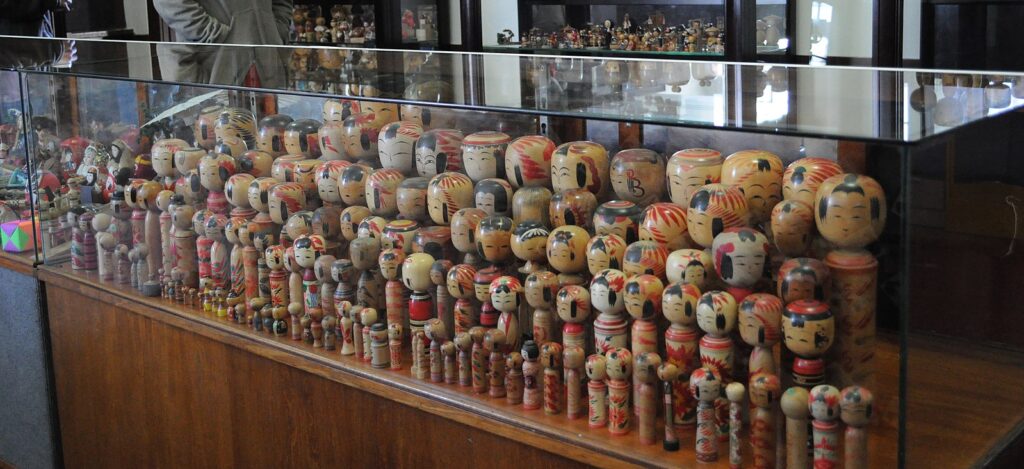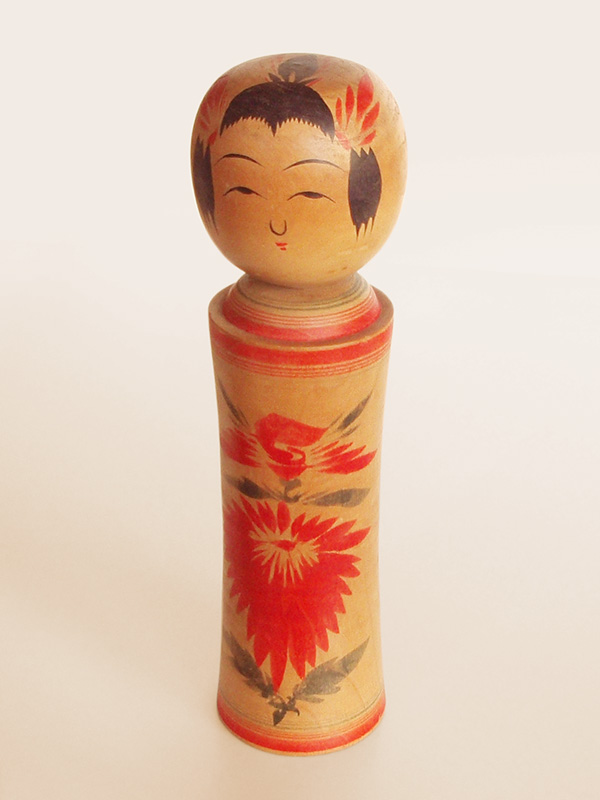What kind of doll did you play with as a child? Cabbage Patch Dolls and Barbies have ruled the market for a long time, at least in America. But did you know that dolls have been popular with children throughout the world for centuries?
Dolls of all sorts have been beloved by kids for ages, providing hours of entertainment, love, and laughter. One type of doll that has held the attention of little girls and boys throughout history is called the Kokeshi, a style of wooden doll created in Japan.
These beautiful dolls are considered to be a poignant symbol of a rich and colorful history in Japan. Even now, these simple, yet charming figures are gaining in popularity across the globe.
Let’s look a little deeper into the Japanese Kokeshi doll!

What is a Japanese Kokeshi Doll?
Kokeshis are a traditional Japanese folk art, originally crafted out of wood and hand-painted with vibrant, simple designs. It is well-accepted that they began in the Tohoku region in northern Honshu, where they are still popular to this day.
Although they are extremely varied, you can usually expect a couple of things from each and every one of these charming dolls. There are a few features that are considered must-have characteristics, such as a cylindrical body, round head, no arms or legs, and very simply drawn faces.
However, beyond those basic elements, Kokeshis are incredibly diverse. There is no specific shape for a typical Kokeshi doll.
However, there is a standard, iconic design that is often used. They are carved out of a single piece of wood, usually either mizuki or cherry wood, and usually crafted on a lathe.
Kokeshis are hand-painted using simple brush strokes. These create a vivid and captivating appearance.
In the beginning, the dolls only featured three colors–red, black, and yellow. But this has changed and expanded to include any imaginable color in modern times.
Many Kokeshi artists include designs that represent the natural world, such as flowers and animals. The designs of the kokeshi dolls can also correlate to where they were created.
Where Did Kokeshi Dolls Originate?
Kokeshi dolls have been around for a long time–from the Edo period, 1603-1868, to be exact. They came to be made at or near onsens, or hot springs, where craftsmen would often be making other wooden objects like bowls and drinking cups with a lathe.
The easy shape of the Kokeshi dolls lent themselves perfectly to the lathes. So the tiny dolls were made to give children something to play with while their parents were busy elsewhere at the onsen.
The popularity of these dolls spread through Tohoku, with individual onsens and regions creating their own special style of Kokeshi. These days the dolls can be made in one of the 12 authentic styles, or in the creative style, which follows no rules.

What do Kokeshi Dolls Symbolize?
In Japan, Kokeshis are traditionally children’s toys, but there is some meaning behind the little dolls, too. The symbolism behind Kokeshi dolls varies depending on where they are made, why they are gifted, and personal perspectives.
Here are a few common themes associated with Kokeshi dolls:
- Good luck and fortune: Kokeshi dolls are widely thought to provide good luck, good fortune, and even bountiful harvests. They may be gifted to newborns as tokens of well-wishes and love.
- Friendship: Since they are so carefully crafted, Kokeshi dolls are commonly exchanged as tokens of friendship and affection.
- Traditional craftsmanship: Kokeshi dolls are handmade, usually by skilled woodworkers using techniques that have been passed down through generations. This connection to the past means that Kokeshi dolls are important symbols of cultural heritage.
- Changing of the seasons: Modern creative Kokeshi, also known as Sosaku Kokeshi, are sometimes painted with images of the changing seasons, like cherry blossoms and snowflakes.
- Simplicity: Because of their basic design–round head and cylinder body, all made from wood, Kokeshi dolls celebrate simple, natural beauty. Minimally painted Kokeshi invites admirers to appreciate the grain and color of the wood without the paint.
What Are the 12 Types of Kokeshi?
As we mentioned before, Kokeshi dolls originated in the northern region of Japan known as Tohoku. Within Tohoku, there are six regions, or prefectures: Aomori, Akita, Iwate, Yamagata, Miyagi, and Fukushima.
Kokeshi aren’t just linked to these prefectures, or regions therewithin, but also the onsens found in these prefectures.
Onsens were popular gathering places even in ancient times. Goods, like Kokeshi dolls, were regularly sold there. Today, onsens are still popular tourist destinations and have gift shops with Kokeshi, just like their ancestors would sell.
There are 12 main types of Kokeshi dolls, which are as follows:
- Naruko Kokeshi: From the Naruko region inside the Miyagi Prefecture, usually painted with floral designs and featuring a wooden collar around the neck.
- Tsuchiyu Kokeshi: Originating in the Tsuchiyu region of Fukushima Prefecture, these dolls are usually simplistic.
- Yajiro Kokeshi: Normally painted in shades of red and black, these Kokeshi come from the Yajiro region in Yamagata Prefecture.
- Sakunami Kokeshi: Also from the Miyagi Prefecture, these Kokeshi are taller and more slender than others.
- Togatta Kokeshi: From the Zao part of the Yamagata Prefecture, these dolls are known to feature geometric patterns.
- Kijiyama Kokeshi: Hailing from the Akita Prefecture, these Kokeshi will be painted with soft pastel colors.
- Hijiori Kokeshi: One of the rarest styles of Kokeshi, Hijiori Kokeshi comes from the Hijiori Onsen in Yamagata. It is said that there is only one master left who knows how to create these dolls perfectly.
- Nanbu Kokeshi: From the Aomori Prefecture, Nanbu Kokeshi are minimalistic in style and color.
- Zao Kokeshi: Originating from the Zao region of Yamagata, these Kokeshi are known for being bold and bright.
- Tsugaru Kokeshi: Intricately painted and patterned, this Kokeshi type hails from the Tsugaru region of Aomori Prefecture.
- Nakanosawa Kokeshi: The most recently recognized authentic style, the Nakanosawa Kokeshi has flared nostrils and a bright, eye-catching pink blush.
- Yamagata: Coming from, and named for, the Yamagata Prefecture, this style of Kokeshi relies heavily on floral design patterns.

Sosaku Kokeshi
Unlike the 12 authentic styles, Sosaku Kokeshi first started to take off in the 1950s. It brought new, worldwide attention to Kokeshi dolls.
Since Sosaku, or Creative Kokeshi, doesn’t adhere to any of the 12 authentic styles, the artist has free rein to do what they please. This invites all sorts of modern art styles and movements into the art of Kokeshi making, renewing and refreshing the craft for a modern age.
References
“Kokeshi Dolls – An In-Depth Guide”
https://mingeiarts.com/pages/kokeshi-dolls
“Kokeshi Dolls: Not Your Typical Toys”
https://www.japan.travel/en/ph/special-features/kokeshi-dolls